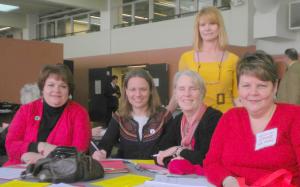All right! The legislative session is over! One huge bright spot? The maintenance in full of National Board stipends! It was a hard fought battle, and here in the 24th Legislative District, we did our part.
Some of you joined us recently, and some of you have been with us since the beginning of our National Board Local Action Network last year. In any case, our advocacy took on many forms this school year and legislative session. Collectively, our efforts were impressive–thanks to each of you for your work!
We started the year by building relationships with our local lawmakers through inviting legislators to our classrooms. Representative Kevin Van De Wege, Representative Steve Tharinger, and Senator Jim Hargrove all visited with NBCTs and their students in schools. As the Peninsula Daily News commented after a visit to NBCT Shannon Lowrie’s class, this “scored a trifecta of legislative visits.”
Then we had some fun at a local screening of the movie Mitchell 20, accompanied by a discussion and writing postcards to legislators. Community members, a superintendent, a school board member, and teachers from four different school districts all attended this screening! Special thanks to NBCT Patti Smith, Chimacum EA Vice President, and Todd Miller, Chimacum EA President, on this.
The legislative session was tough. We faced dark times with a thousand dollar reduction from the House, followed by an unbelievable 75% reduction from the Senate Republican budget.
How did 24th District NBCTs respond?
- Spoke with Rep. Tharinger at a town hall meeting in Quilcene, and with Sen. Hargrove at a Jefferson County Democrats meeting in Chimacum
- Met with legislators in their offices and on the house and senate floors. NBCTs Denise Williamson, Quilcene EA; Brian Berg, Sequim EA; John Henry, Port Angeles EA; and Patti Smith and I from the Chimacum EA all traveled to Olympia for this.
- Testified before the House and Senate Education committees, and even if it was on other education issues, made sure to put in a good word for National Board Certification!
- Invited legislators to our classrooms
- Built community through watching Mitchell 20
- Wrote a group letter to Senator Hargrove signed by 38 NBCTs from the 24th Legislative District opposing the Senate Republican Budget
We also participated in our outstanding statewide efforts coordinated by Dr. Jim Meadows and Local Action Networks in each legislative district. What did we do?
- Sent emails. Across the state, THOUSANDS of emails, literally, were sent by NBCTs.
- Made phone calls! Our statewide effort pretty much shut the legislative switchboard down for a bit on the evening of March 8!
- Statewide, over 3,100 people signed a petition started by NBCT Krista Calvin, Richland EA.
What response did we get from our actions? Well, the end result of full support for the National Board program speaks to our advocacy efforts and to the value legislators place on the positive impact of National Board Certification on student learning.
Locally we were heard as well. Our very own Senator Jim Hargrove proposed an amendment to fully support the National Board program. When introducing his amendment on the senate floor, he said, “The teachers in my district say that this has made a huge difference in their classrooms.” Yes, that’s right. Who did he listen to on this issue? Us! You know what that means? We’ve got to stay out there and make our voice heard, because people are paying attention!
Senator Christine Rolfes was another senator that some of us from the 24th district visited. Her response to Hargove’s National Board amendment? In the debate, she said, “When will this war on teachers stop? This is a year when we don’t have to cut their National Board salaries. We don’t have to cut funding to the schools. Our teachers have lost their income; we’ve crowded their classrooms. We’ve taken away funding for resources for extra stuff like construction paper and staples. And we don’t have to do it. So when does the war on teachers stop, and when does the war on public schools stop if we don’t stop it this year?”
Not content to lobby only for National Board Certification, 24th Legislative District NBCTs got involved in advocacy for health insurance, high stakes assessment, charter schools, and teacher evaluation. 38 of us signed a group letter to Senator Jim Hargrove asking him to oppose the Senate Republican Budget, which was so harmful to education in so many ways. NBCT Al Gonzalez even posted about this group letter on his blog.
It’s not over! We have some next steps!
- You know what National Board Certification has meant to you and your students. Now is a great time to share that with potential new candidates! The second and last round this year of the Washington State Conditional Loan opens April 23, 2012 and closes May 18. More National Board Information.
- In terms of political advocacy, what’s coming up? Well, it’s an election year! When it comes to the education issues we care about, who are we going to be trying to lobby next year? The candidates we elect now. One of the gubernatorial candidates, Jay Inslee, even mentioned National Board Certification in his education platform, saying he wanted to “Build upon the successful efforts of the Washington Education Association and others to increase the number of teachers who achieve National Board Certification.” You’ve honed some political skills and become familiar with some issues through LAN involvement. Maybe this is the year to get involved in a campaign!
Keep in touch! Join us on Facebook, follow us on Twitter @WEAnbcts, send an email.
(This post was written as an email to members of the National Board Local Action Network in the 24th Legislative District, which covers the Olympic Peninsula.)








